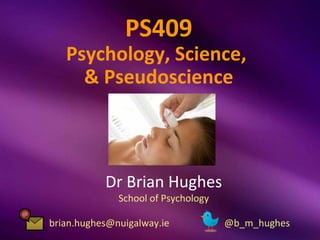
Psychology, Science, and Pseudoscience: Class #08 (Social, Media)
- 1. PS409 Psychology, Science, & Pseudoscience Dr Brian Hughes School of Psychology brian.hughes@nuigalway.ie @b_m_hughes
- 2. Evidentiary reasoning: Why do people believe weird things?
- 3. Motivation Common illusions Benefits Unrealistically positive self-regard Happiness or contentment Illusions of control Ability to care for others Unrealistic optimism Capacity for creativity/productivity
- 4. Second-hand information After Gilovich (1991): Distortions due to memory limitations Distortions due to bias Malevolent: e.g., fraud Benevolent: e.g., face-saving Distortions to enhance efficiency of communication Sharpening/levelling of details Embellishment with additional ‘detail’ Distortions due to plausibility adjustment Urban legends (snopes.com)
- 5. First-hand information Tendency to believe others are more susceptible to cognitive biases than self Tendency to attach greater weight to one’s own ability to withstand bias than to ability of others -- Pronin et al. (2004)
- 6. Exaggerated impressions of agreement The “social false-consensus effect” (Ross et al., 1977; Dawes, 2001) A false belief that other people share our views Why? Selective exposure Inadequate social feedback
- 7. Conclusion Cognitive and social factors The existence (or popularity) facilitate the spread of of a pseudoscience is not unfounded claims necessarily linked to its validity, efficacy, or utility
- 8. The role of the media
- 9. The language of science
- 10. The language of science “American scientific companies are cross- breeding humans and animals, and coming up with mice… with fully functioning human brains…” Christine O’Donnell, 15 November 2007
- 11. The language of science Top: Winder (2006). UNAIDS/06.25E Bottom: Mills et al. (2004). American Journal of Psychiatry, 161(2), 278-285.
- 12. Science in the Media Relevance of Research Related Research News Numbers Audience Experts Theory Procedures Social Context 0 20 40 60 80 100 From: Zimmerman et al. (2001). Public Understanding of Science, 10, 37-58.
- 13. Science in the Media Relevance of Research Related Research News Numbers Audience Experts Theory Procedures Social Context 0 20 40 60 80 100 From: Zimmerman et al. (2001). Public Understanding of Science, 10, 37-58.
- 14. Science in the Media Relevance of Research Related Research News Numbers Audience Experts Theory Procedures Social Context 0 20 40 60 80 100 From: Zimmerman et al. (2001). Public Understanding of Science, 10, 37-58.
- 15. Media Frames Nanotech GM food Archaeology Social Safety Empiricism consequences vs. Custom
- 16. Media Frames Nanotech Benefits Concern outweigh about Risk- Risks Benefit balance Risks outweigh Social Benefits consequences From: Stephens (2005). Scientific Communication, 27, 175-199.
- 17. Media Metaphors From: Ungar (2000). Public Understanding of Science, 9, 297-312.
- 18. Media Triggers 80 120 70 100 60 80 50 40 60 30 NY Times 40 20 Wash Post 20 NY 10 0 0 DC 1990 1991 1992 1993 1994 1995 Shanahan & Good (2000). Public Understanding of Science, 9, 285-295.
- 19. Portrayal of Scientists Seven primary stereotypes: The evil alchemist The noble scientist as hero The foolish scientist The inhuman researcher The scientist as adventurer The mad, bad, dangerous scientist The helpless scientist, unable to control the outcomes of his/her work Haynes (2003). Public Understanding of Science, 12, 243-253.
- 20. Portrayal of Scientists “Throughout Western culture, despite the existence of other figures and stereotypes, the master narrative of the scientist is of an evil maniac and a dangerous man.” Haynes (2003). Public Understanding of Science, 12, 243-253.
- 21. News Logic: Restrictions on the Messengers Limited space/airtime Preference for “hard” news Tight deadlines/budgets Press releases/ Churnalism Competitive market
- 22. Summary Audiences and scientists see science differently Media reporting employs narrative frames Media translations rely on metaphors Public interest in science responds to cultural triggers Views of scientists are stereotyped Journalists work in very restrictive environments
- 23. PS409 Psychology, Science, & Pseudoscience Dr Brian Hughes School of Psychology brian.hughes@nuigalway.ie @b_m_hughes
Notas del editor
- Knowledge-ignorance paradox
- Knowledge-ignorance paradox
